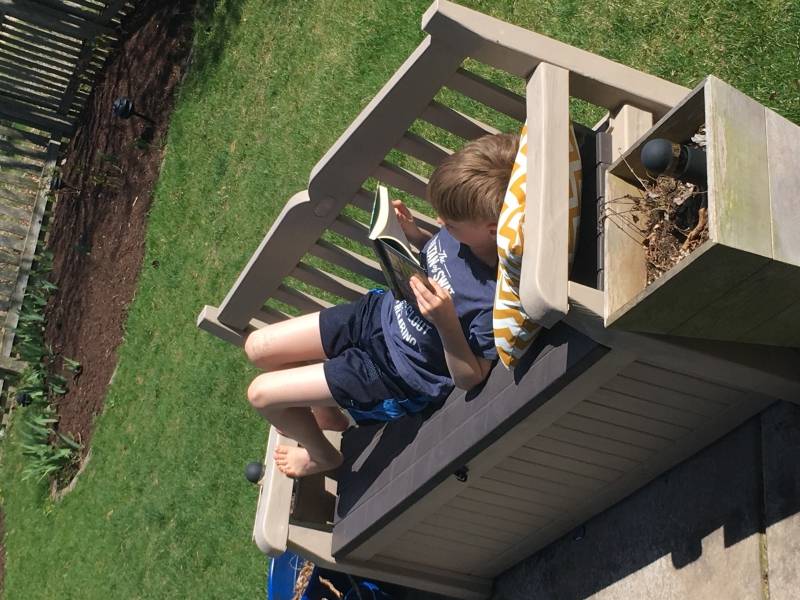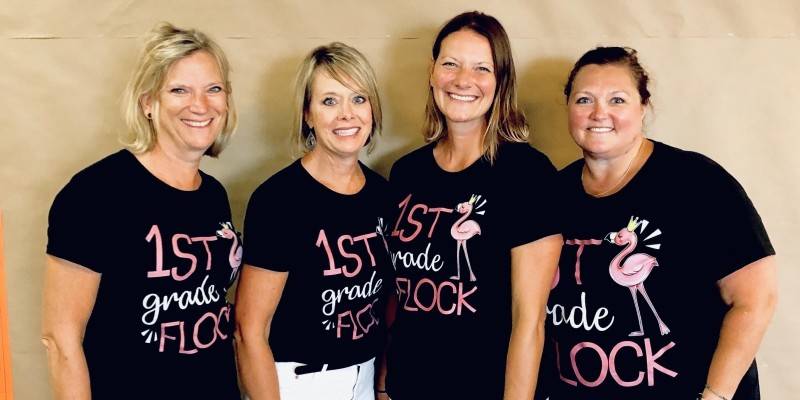The 2019-2020 school year is wrapping up in a way that perhaps only a first grader could have imagined during a class writing prompt. Those of us who did not anticipate this have been left scrambling to keep kids learning as best we can for the remainder of the year. Chromebooks went out to every child who needed one, and Champaign and Urbana schools shifted to online teaching as soon as spring break ended.
<span 0.875em;”=””>Carrie Busey Elementary first grade teachers Maggie Beckett, Gay Cabutti, Laura Retallick, and Noelle Stinson tried to connect with every student once per week. That goal could be difficult considering family working schedules and access to the internet. “We all have virtual meetings we offer our students at least a few times a week. Attendance can be hit or miss,” said Retallick. “We have made attempts to do evening and weekend virtual meetings to wrap in some of the kids whose parents are working in essential jobs outside the home.”
The group is well known for working and teaching as a team; getting to know every student in the grade so they can all best support one another and the class, and they have been through a lot together. “We’ve worked together through many professional and personal challenges and consistently stepped up to support to the best of our ability for years,” said Stinson. Still, pandemic distance learning is new.
The teachers wanted to focus on students’ social-emotional well-being more than any academic measure. “Our check-ins and lessons are to provide opportunities for kids to see us and each other. We want to support what parents are doing at home, provide opportunities for structure and take some of the pressure off of families,” said Stinson.
“We know that as humans we require connection with others, so setting up meetings where kids can see each other and share with each other fills at least some of the void they are feeling,” said Retallick. “What we are discovering is that we need this connection as much as the kids do!”
A combination of video calls, eLearning websites, and phone calls have all been part of connection. “Whatever works best for all parties involved has been our mantra,” said Cabutti. It’d be easier if there was just one simple way to connect and teach, but “with all of this being unplanned everyone just had to do what worked best for them,” she said. “Getting devices in the hands of all of the students and getting them logged on took a lot of communication and patience.”
“Although the learning curve was steep, especially getting up and running with different aspects of technology — and we had to scramble to do that fairly quickly — we all feel a sense of accomplishment in the way we discovered many unique ways to reach and teach our students,” said Retallick. Working their way through those challenges is just another way they’ve grown together as a team. “Sharing materials, formats, and technical assistance has been really important throughout this eLearning adventure,” said Stinson. “We use several methods to have face-to-face meetings, and are becoming more effective with that.”
Everyone has been a roller coaster of emotions. “A couple of us maybe are not the most tech-y people on the planet,” said Cabutti. “Learning new programs, formats, and a lack of scheduled structure have been frustrating, challenging, and down right hard. I can’t imagine having young children during this time because of the layers of frustration and angst, so kudos to Mrs. Stinson.”
Stinson, with two elementary-aged children of her own, said she’s not getting to binge many Netflix series these days, and she’s fully empathizing with parents trying to teach from home. “Like so many working parents, my husband and I had a schedule that felt busy but mostly balanced before all of this,” said Stinson. Like so many of us, her work-life balance has blended in strange ways and she’s feeling less efficient.
“We both try to be responsive to what our kids need and what is non-negotiable regarding our work schedules,” she said. “It’s a good time to practice the art of grace for ourselves, our kids and each other. It’s a different ballgame getting them motivated to do schoolwork outside of the social-and-developmentally geared structures provided in school, regardless of if you have experience and training!” She encouraged all parents and guardians to work through this with a lot of grace for yourselves and the kids.
The emotional well-being is clearly forefront in the first grade teachers’ minds. They are wanting to make sure that their students are physically safe, and also feel safe.
“School is important, but so much of what it provides is socialization and community. Teachers know academics will come only after kids feel physically and emotionally safe,” said Stinson. “The rest will come.”
Cabutti said she knew many of her families were overloaded, and suggested using teachers as a scapegoat. “Be sure you are asking your child to read each day, or read to them and talk about the story. Of course there is some push back because not all activities are favored by all kids. We tell our parents to ‘blame it on the teacher,’” she said.

The author’s son getting caught up on reading. Photo by Erin Ewoldt.
They suggested taking this opportunity to share knowledge that schedules didn’t previously have time for: how to make a sandwich, plant seeds, fold towels, play a new board game. “It is hard to think of positives when it comes to this, but we see that kids are being given more time to explore, which allow them to learn in broader ways than a traditional classroom might allow,” said Retallick. “They are not overscheduled, and perhaps more rested than usual. As a team we know that our students need more time for transitions and play than we are able to give, so we are interested in the undoubtable growth in many areas we will see upon returning to school.” They expect academic gaps, but also expect growth in other areas.
The teachers are thankful for the ways Champaign-Urbana has supported students and families in need. “It’s amazing to see how everyone has come together to provide for our most vulnerable kids and families making sure they’re fed, have a place to go if parents need to work,” said Stinson. “It’s a huge relief to share the responsibility of our students’ well-being with such a caring community.”
They miss their students and are grieving the opportunity to say goodbye in person. They also miss one another, and look forward to working in person after being stretched in their teaching this quarter.
“It’s cool to observe that the relationships built within four walls stretch so far beyond them while we make it a collective priority to lift each other up,” said Stinson. “It’s pushed teachers to prioritize what academic and social pieces are most important to provide for our kids. We are growing in our creativity, tech skills and efficiency. It feels hard but has potential to benefit our practices in the long run.”
Top photo provided by Maggie Beckett.








